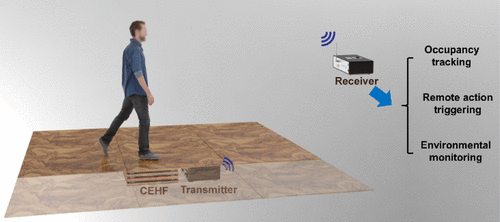当前位置:
X-MOL 学术
›
ACS Appl. Mater. Interfaces
›
论文详情
Our official English website, www.x-mol.net, welcomes your
feedback! (Note: you will need to create a separate account there.)
Energy Harvesting Floor from Commercial Cellulosic Materials for a Self-Powered Wireless Transmission Sensor System
ACS Applied Materials & Interfaces ( IF 8.3 ) Pub Date : 2021-01-20 , DOI: 10.1021/acsami.0c20703 Long Gu 1 , Lazarus German 1, 2 , Tong Li 1 , Jun Li 1 , Yan Shao 1 , Yin Long 1 , Jingyu Wang 1 , Xudong Wang 1
ACS Applied Materials & Interfaces ( IF 8.3 ) Pub Date : 2021-01-20 , DOI: 10.1021/acsami.0c20703 Long Gu 1 , Lazarus German 1, 2 , Tong Li 1 , Jun Li 1 , Yan Shao 1 , Yin Long 1 , Jingyu Wang 1 , Xudong Wang 1
Affiliation

|
Cellulose-based materials have gained increasing attention for the development of low-cost, eco-friendly technologies, and more recently, as functional materials in triboelectric nanogenerators (TENGs). However, the low output performance of cellulose-based TENGs severely restricts their versatility and employment in emerging smart building and smart city applications. Here, we report a high output performance of a commercial cellulosic material-based energy harvesting floor (CEHF). Benefiting from the significant difference in the triboelectric properties between weighing and nitrocellulose papers, high surface roughness achieved by a newly developed mechanical exfoliation method, and large overall contact area via a multilayered device structure, the CEHF (25 cm × 15 cm × 1.2 cm) exhibits excellent output performance with a maximum output voltage, current, and power peak values of 360 V, 250 μA, and 5 mW, respectively. It can be directly installed or integrated with regular flooring products to effectively convert human body movements into electricity and shows good durability and stability. Moreover, a wireless transmission sensing system that can produce a 1:1 footstep-to-signal (transmitted and received) ratio is instantaneously powered by a TENG based entirely on cellulosic materials for the first time. This work provides a feasible and effective way to utilize commercial cellulosic materials to construct self-powered wireless transmission systems for real-time sensing applications.
中文翻译:

用于自供电无线传输传感器系统的商用纤维素材料的能量收集地板
纤维素基材料作为低成本,环保技术的发展越来越受到关注,最近,它作为摩擦电纳米发电机(TENGs)中的功能材料。但是,纤维素基TENG的低输出性能严重限制了它们在新兴的智能建筑和智能城市应用中的多功能性和就业。在这里,我们报告了基于商业纤维素材料的能量收集地板(CEHF)的高输出性能。得益于称量纸和硝化纤维纸之间的摩擦电特性的显着差异,通过新开发的机械剥落方法获得的高表面粗糙度以及通过多层设备结构CEHF(25 cm×15 cm×1)获得的较大总接触面积。2 cm)具有出色的输出性能,最大输出电压,电流和功率峰值分别为360 V,250μA和5 mW。它可以直接安装或与常规地板产品集成在一起,以有效地将人体运动转化为电能,并具有良好的耐久性和稳定性。此外,首次完全由纤维素材料制成的TENG瞬时为可产生1:1脚步信号与信号(发送和接收)之比的无线传输传感系统提供了动力。这项工作为利用商业纤维素材料构建用于实时传感应用的自供电无线传输系统提供了一种可行而有效的方法。它可以直接安装或与常规地板产品集成在一起,以有效地将人体运动转化为电能,并具有良好的耐久性和稳定性。此外,首次完全由纤维素材料制成的TENG瞬时为可产生1:1脚步信号与信号(发送和接收)之比的无线传输传感系统提供了动力。这项工作为利用商业纤维素材料构建用于实时传感应用的自供电无线传输系统提供了一种可行而有效的方法。它可以直接安装或与常规地板产品集成在一起,以有效地将人体运动转化为电能,并具有良好的耐久性和稳定性。此外,首次完全由纤维素材料制成的TENG瞬时为可产生1:1脚步信号与信号(发送和接收)之比的无线传输传感系统提供了动力。这项工作为利用商业纤维素材料构建用于实时传感应用的自供电无线传输系统提供了一种可行而有效的方法。首次完全由纤维素材料制成的TENG立即为1脚步对信号(发送和接收)的比率供电。这项工作为利用商业纤维素材料构建用于实时传感应用的自供电无线传输系统提供了一种可行而有效的方法。首次完全由纤维素材料制成的TENG立即为1脚步对信号(发送和接收)的比率供电。这项工作为利用商业纤维素材料构建用于实时传感应用的自供电无线传输系统提供了一种可行而有效的方法。
更新日期:2021-02-03
中文翻译:

用于自供电无线传输传感器系统的商用纤维素材料的能量收集地板
纤维素基材料作为低成本,环保技术的发展越来越受到关注,最近,它作为摩擦电纳米发电机(TENGs)中的功能材料。但是,纤维素基TENG的低输出性能严重限制了它们在新兴的智能建筑和智能城市应用中的多功能性和就业。在这里,我们报告了基于商业纤维素材料的能量收集地板(CEHF)的高输出性能。得益于称量纸和硝化纤维纸之间的摩擦电特性的显着差异,通过新开发的机械剥落方法获得的高表面粗糙度以及通过多层设备结构CEHF(25 cm×15 cm×1)获得的较大总接触面积。2 cm)具有出色的输出性能,最大输出电压,电流和功率峰值分别为360 V,250μA和5 mW。它可以直接安装或与常规地板产品集成在一起,以有效地将人体运动转化为电能,并具有良好的耐久性和稳定性。此外,首次完全由纤维素材料制成的TENG瞬时为可产生1:1脚步信号与信号(发送和接收)之比的无线传输传感系统提供了动力。这项工作为利用商业纤维素材料构建用于实时传感应用的自供电无线传输系统提供了一种可行而有效的方法。它可以直接安装或与常规地板产品集成在一起,以有效地将人体运动转化为电能,并具有良好的耐久性和稳定性。此外,首次完全由纤维素材料制成的TENG瞬时为可产生1:1脚步信号与信号(发送和接收)之比的无线传输传感系统提供了动力。这项工作为利用商业纤维素材料构建用于实时传感应用的自供电无线传输系统提供了一种可行而有效的方法。它可以直接安装或与常规地板产品集成在一起,以有效地将人体运动转化为电能,并具有良好的耐久性和稳定性。此外,首次完全由纤维素材料制成的TENG瞬时为可产生1:1脚步信号与信号(发送和接收)之比的无线传输传感系统提供了动力。这项工作为利用商业纤维素材料构建用于实时传感应用的自供电无线传输系统提供了一种可行而有效的方法。首次完全由纤维素材料制成的TENG立即为1脚步对信号(发送和接收)的比率供电。这项工作为利用商业纤维素材料构建用于实时传感应用的自供电无线传输系统提供了一种可行而有效的方法。首次完全由纤维素材料制成的TENG立即为1脚步对信号(发送和接收)的比率供电。这项工作为利用商业纤维素材料构建用于实时传感应用的自供电无线传输系统提供了一种可行而有效的方法。











































 京公网安备 11010802027423号
京公网安备 11010802027423号